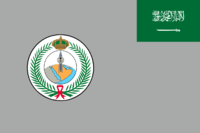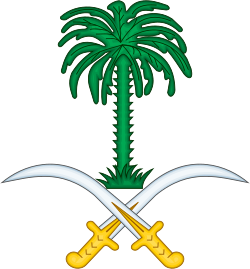Royal Saudi Strategic Missile Force
The Royal Saudi Strategic Missile Force (Arabic: قوة الصواريخ الإستراتيجية الملكية السعودية) or RSSMF is the fifth branch of the Saudi Arabian Armed Forces, responsible for commissioning long-range strategic missiles. The RSSMF formerly had its headquarters in an underground command facility in Riyadh– the capital of Saudi Arabia.
| Royal Saudi Strategic Missile Force | |
|---|---|
| قوة الصواريخ الاستراتيجية الملكية السعودية | |
 Emblem | |
| Founded | 8 September 1986 |
| Country | |
| Allegiance | CTHM |
| Branch | Defense |
| Type | Strategic missile force |
| Role | Strategic deterrence |
| Size | 40,000[1] |
| Part of | Royal Armed Forces
|
| Headquarters | Riyadh 4 (or 5) bases |
| Anniversaries | 8 September (33 years ago) |
| Commanders | |
| Current commander | Lt. General Jarallah Alaluwayt |
| Insignia | |
| Flag |  |
The facility coordinated Saudi Arabia's advanced "Peace Shield" radar and air defense systems. In July 2013, the new RSSMF headquarters and academy buildings were officially opened by Prince Khalid bin Sultan bin Abdulaziz and current RSSMF commander Lieutenant general Jarallah Alaluwayt.[2][3]
History
The RSSMF's role has grown rapidly since Saudi Arabia and other Arab States of the Persian Gulf announced in 2009 an initiative to obtain nuclear weapons as a countermeasure to the Iranian nuclear program. King Abdullah of Saudi Arabia and Prince Turki bin Faisal Al Saud, a former Saudi intelligence chief and ambassador to Washington, both mentioned the Persian Gulf states could acquire their own nuclear weapons as a countermeasure to Iran's.[4] [5] [6] [7] [8]
Some experts speculate (by taking into account Saudi Arabia's financial contribution to Pakistan's nuclear weapons program) that Saudi Arabia may receive or has already received nuclear weapons from Pakistan. One report by the BBC claims "it is a cash-and-carry deal for warheads, the first of those options sketched out by the Saudis back in 2003; others that it is the second, an arrangement under which Pakistani nuclear forces could be deployed in the Kingdom."[9]
Facilities
In total [10] RSSMF operates 4 (probably 5) bases:
1. The Strategic Missile Force has a modern underground ballistic missile base with number 544 which was built in 2008 - the Al-Watah ballistic missile base (discovered with the help of satellite images)[11] - in the rocky central part of Saudi Arabia, some 200 km southwest of the capital city of Riyadh. The base has a security perimeter with a checkpoint on the main road, as well as extensive storage and underground facilities. It also includes administrative buildings, two launch pads, a communications tower and seven gates leading to the underground facilities. Fortified depots for launchers lie behind the secondary checkpoint in the ravine area.
2. One more partially underground base Rawdah (Raniyya) under the number 533 lies 550 km south-west from the capital and 23 km south of city Ranyah as it stated.[10] Tunnel across the rocky ridge has two entrances which have coordinates (21°3'33"N 42°53'2"E) and (21°3'16"N 42°52'52"E), base itself: 21°2′59.3″N 42°52′36.8″E. At the 21°2.42′N 42°52.43′E one can clearly see 87 old DF-3 Chinese missiles (probably for training).
Two older bases have similar characteristics, suggesting that they share the same role. Each complex has two missile garrisons (one in the North and another in the South) with another area serving housing, maintenance and administrative functions. The garrisons themselves are located a short distance away within a secured complex. The administrative and support complexes are outside the security perimeter:
3. It is the oldest (from 1988) Al Sulayyil ballistic missile base[12][13] with number 522 is also known as Wadi ad-Dawasir. Al Sulayyil base was built by the Chinese and lies approximately 450 km southwest of the capital.
4. Al Jufayr (Al Hariq) base with number 511 lies approximately 70–90 km south of Riyadh.[10] The Google photos of the area were blurred before 2014. Now the communication tower is visible on the hill near the road (24°1'52"N 46°18'39"E). The asphalted road goes from (23°59′36.1″N 46°15′04.1″E) and continue into nothing at (23°56′27.7″N 46°10′58.4″E), but nearby one can see places for erector-launchers (23°55.29′N 46°11.37′E).
5. The last unconfirmed base, Ash Shamli under the number 566, probably lies in the desert (27°15'49"N 40°03'14"E or 27°39'52"N 40°14'14"E) roughly 750 km north-west of the Saudi capital.
Delivery systems
| Model | Image | Origin | Quantity | Details |
|---|---|---|---|---|
| DF-3 |  | 30+ | The main weapon of the RSSMF is the Chinese DF-3 (CSS-2, Dongfeng missile), which carries a conventional high-explosive warhead (2150 kg) and is a variant of the DongFeng 3A Intermediate-range ballistic missile. The missile has a maximum range of 4,000 km and was delivered following an order made by Saudi Arabia in 1987.[14] About 30+ missiles and 9~12 transporter erector launchers (TEL) were reportedly delivered in 1988, however no known test-launch has been made in the country.Saudi Arabia publicly displayed them for the first time in 2014.[15] | |
| DF-21 |  | Unknown | In 2013, media reports appeared suggesting that the RSSMF would consider purchasing the advanced DF-21 ballistic missile from China in the future.[16][17] In January 2014, Newsweek revealed that Saudi Arabia had secretly bought a number of DF-21 medium-range ballistic missiles in 2007. They also said that the American CIA had allowed the deal to go through as long as the missiles were modified to not be able to carry nuclear warheads. While the DF-3 has a longer range, it was designed to carry a nuclear payload, and so had poor accuracy (300 meters CEP) if used with a conventional warhead. It would only be useful against large area targets like cities and military bases. This made them useless during the Gulf War for retaliating against Iraqi Scud missile attacks, as they would cause mass civilian casualties and would not be as effective as the ongoing coalition air attacks. After the war, the Saudis and the CIA worked together to covertly allow the purchase of Chinese DF-21s. The DF-21 is solid-fueled instead of liquid-fueled like the DF-3, so it takes less time to prepare for launch. It is accurate to 30 meters CEP, allowing it to attack specific targets like compounds or palaces. The Saudis are not known to possess mobile launchers, but may use some 100~125 launchers originally bought with the DF-3s. The number of DF-21 missiles that were bought is unknown. Newsweek speculates that details of the deal being made public is part of Saudi deterrence against Iran.[15][18][19] | |
See also
| Wikimedia Commons has media related to R.S. Missile Defense. |
- R.S. Air Defense
- Golden Wheel Project (Dongfeng missiles operator in Saudi Arabia)
References
- "Saudi Arabia spends 25% of its budget on its military — here's what it has for the money". www.uk.businessinsider.com. Archived from the original on 2 January 2016. Retrieved 23 March 2017.
- @ SaudiArmyNews "Arabic:المملكة العربية السعودية هي الدولة العربية الوحيدة التي من ضمن فروع قواتها المسلحة فرع رئيسي يسمى - Saudi Arabia is the only Arab country with a "Strategic Missile Force" branch Archived 4 October 2013 at the Wayback Machine, Twitter @ SaudiArmyNews, July 2013.
- "Arabic:قوة الصواريخ الإستراتيجية الملكية السعودية - The power of the Saudi royal strategic missiles". National Kuwait. July 2013. Archived from the original on 26 November 2013. Retrieved 3 November 2018.
- US embassy cables: Saudi official warns Gulf states may go nuclear Archived 4 July 2017 at the Wayback Machine, The Guardian, 28 November 2010.
- Saudi Arabia urges US attack on Iran to stop the nuclear program. Archived 16 February 2017 at the Wayback Machine The Guardian, 28 November 2010.
- Riyadh will build nuclear weapons if Iran gets them, Saudi prince warns Archived 16 February 2017 at the Wayback Machine The Guardian, 29 June 2011.
- Dennis Ross: Saudi king vowed to obtain nuclear bomb after Iran Archived 28 September 2013 at the Wayback Machine Haaretz, 30 May 2012.
- King Says Saudi Arabia Would Need Nukes to Counter Iran Arsenal Archived 4 October 2013 at the Wayback Machine The Nuclear Threat Initiative, 30 May 2012.
- Mark Urban: Saudi nuclear weapons 'on order' from Pakistan Archived 7 November 2013 at the Wayback Machine BBC News, 6 November 2013.
- «Why Did Saudi Arabia Buy Chinese Missiles?» Archived 13 September 2017 at the Wayback Machine, 30 January 2014.
- Sean O'Connor - IHS Jane's Defence Weekly. "Saudi ballistic missile site revealed" Archived 14 July 2013 at the Wayback Machine, IHS Jane's Defence Weekly, 10 July 2013.
- Ronen Bergman - GlobalSecurity.org. "Al Sulayyil Missile Base" Archived 4 October 2013 at the Wayback Machine GlobalSecurity.org.
- GlobalSecurity Org. photos "Imagery of Al Sulayyil Missile Base Launch Complex Area" Archived 4 October 2013 at the Wayback Machine GlobalSecurity.org
- SinoDefence "DongFeng 3 (CSS-2) Intermediate-Range Ballistic Missile" Archived 14 August 2013 at the Wayback Machine, 27 February 2009.
- "Saudi Arabia unveils part of strategic missile force - a deterrent move against Iran?". Defense Update. 2 May 2014. Archived from the original on 9 May 2014. Retrieved 9 May 2014.
- Jefrey Lewis - Arms Control Wonk. "Saudi Arabia's Strategic Dyad" Archived 6 October 2015 at the Wayback Machine Arms Control Wonk , 15 July 2013.
- Ala Alrababah; Jeffrey Lewis (15 December 2014). "Saudi Rattles Its Saber". Nuclear Threat Initiative. Archived from the original on 23 December 2014. Retrieved 23 December 2014.
- CIA Helped Saudis in Secret Chinese Missile Deal Archived 10 February 2014 at the Wayback Machine - Newsweek.com, 29 January 2014
- Saudi Ballistic Missiles Secretly Upgraded Archived 22 February 2014 at the Wayback Machine - Strategypage.com, 10 February 2014
